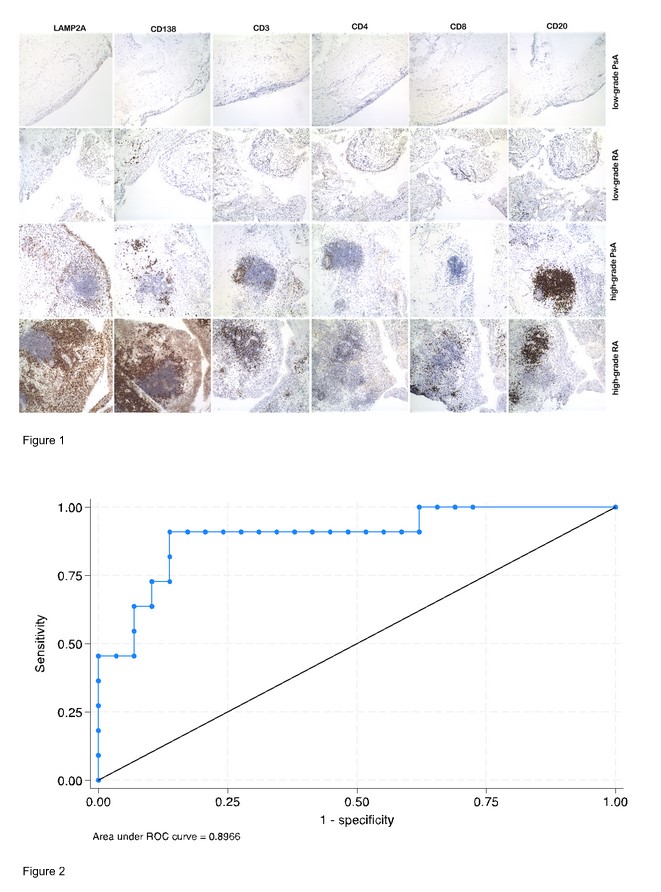Session Information
Date: Monday, November 18, 2024
Title: Abstracts: SpA Including PsA – Diagnosis, Manifestations, & Outcomes II
Session Type: Abstract Session
Session Time: 3:00PM-4:30PM
Background/Purpose: Recent studies have suggested that autophagy may play different roles in the pathogenesis of rheumatoid arthritis (RA) and psoriatic arthritis (PsA). Lysosome-associated membrane protein type 2A (LAMP2A) is a key component of the chaperone-mediated autophagy (CMA) machinery. LAMP2A may be differently regulated in RA and PsA synovial tissue.
This study aims to evaluate LAMP2A expression in synovial tissue as a potential biomarker to distinguish PsA from RA.
Methods: We included 29 patients with classified PsA and 11 patients with classified RA who underwent ultrasound-guided synovial biopsy. Synovial specimens were stained with hematoxylin and eosin (H&E) for Krenn’s score, and anti- CD3, CD4, CD8, CD20, CD138, and recombinant anto-LAMP2A antibodies (Abcam, ab125068). Positivity for each marker was quantified using ImageJ software on microphotographs. The density of LAMP2A-positive cells (n/mm2) was counted in the synovial lining layer, synovial stroma, and inflammatory infiltrate, and compared between PsA and RA with t-test, also stratifying by Krenn’s synovitis grading. Logistic regression analysis was performed to evaluate the ability of LAMP2A-positive cell density to discriminate between RA and PsA. The area under the receiver operating characteristic curve (AUROC) was calculated to assess the diagnostic performance.
Results: he study included 29 PsA patients (mean age 50.53 ± 12.02 years) with a mean DAPSA score of 17.25 ± 4.63 at biopsy. Nineteen (65.52%) PsA synovial specimens had high-grade synovitis (Krenn score ≥ 5). The 11 RA patients (mean age of 53.31 ± 9.31 years) had a mean DAS28 score of 4.36 ± 1.05 at biopsy. Six (54.55%) RA synovial specimens showed high-grade synovitis. LAMP2A-positive cell density in the synovial lining layer was similar between PsA and RA patients (p = 0.26), regardless of synovitis grade. In the synovial stroma, LAMP2A-positive cell density trended towards a difference between PsA and RA (p = 0.08). In high-grade synovitis, RA specimens had higher LAMP2A-positive cell density than PsA patients (p=0.03). LAMP2A-positive cell density in the inflammatory infiltrate was significantly different between PsA and RA patients, with RA specimens displaying higher density than PsA (p=0.0001). This difference was also observed in low-grade synovitis (RA vs. PsA, p=0.008, Figure 1). The density of LAMP2A-positive cells in the inflammatory infiltrate could differentiate RA from PsA (OR 1.02 per point increase, 95% CI 1.01-1.03) with an AUROC of 0.89 (Figure 2).
Conclusion: This study demonstrates that LAMP2A expression in the inflammatory infiltrate of synovial tissue is significantly higher in RA compared to PsA, regardless of the synovitis grade. The density of LAMP2A-positive cells in the inflammatory infiltrate exhibits good diagnostic performance in discriminating RA from PsA, suggesting its potential as a biomarker for differential diagnosis.
To cite this abstract in AMA style:
Venerito V, Cazzato G, Cacciapaglia F, Ceglie E, Del Vescovo S, Caferri T, Lopalco G, Girolamo F, Iannone F. Chaperone-mediated Autophagy in Synovitis Distinguishes Psoriatic Arthritis from Rheumatoid Arthritis [abstract]. Arthritis Rheumatol. 2024; 76 (suppl 9). https://acrabstracts.org/abstract/chaperone-mediated-autophagy-in-synovitis-distinguishes-psoriatic-arthritis-from-rheumatoid-arthritis/. Accessed .« Back to ACR Convergence 2024
ACR Meeting Abstracts - https://acrabstracts.org/abstract/chaperone-mediated-autophagy-in-synovitis-distinguishes-psoriatic-arthritis-from-rheumatoid-arthritis/

